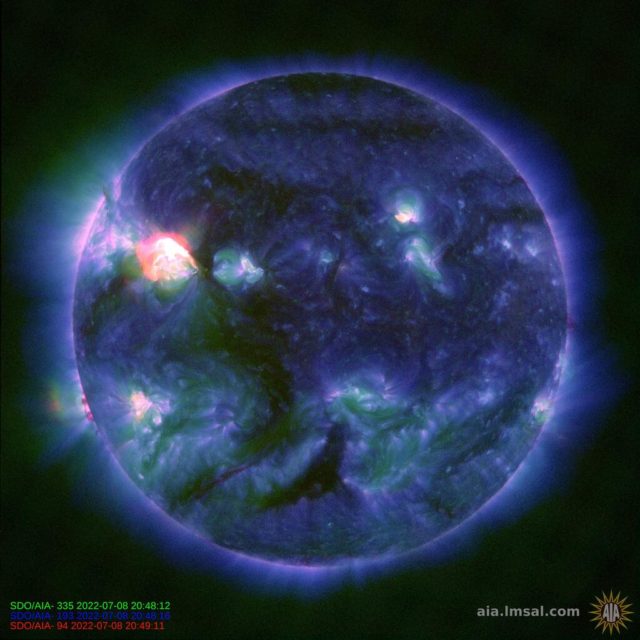The sun as recorded in the extreme ultraviolet part of the spectrum by NASA’s Solar Dynamics Observatory (SDO) between July 6 and July 10. Pay particular attention to the bright orange-pink outburst that occurs on July 8 at the 10:00 position on the solar disk. This was a magnitude 2.6 M-Class flare, a classification one tier below the maximum, X-Class flares.
The featured image for this article is a recent snapshot of the sun in 3 wavebands in the extreme ultraviolet, showcasing the million-degree plasma roiling below what appears to be the benign photosphere. The Photosphere is defined as the solar disk but really is the point where the sun’s gravity balances the outward pressure of the super-heated plasma below.
Observed solar activity such as sunspots, solar flares, coronal mass ejections and prominences are all a measure of the sun’s internal dynamics and energy output. The more outwardly quiescent the sun is, the less active it is internally.
It’s widely known that the sun fluctuates between maximum and minimum activity over an11-year cycle. Recent solar flares suggest a rise in internal solar activity, an observation that would be consistent with the predicted maximum occurring during the spring of 2025 as illustrated here (interactive view) and below (static view)
What is so special about this image?
On July 8 at 20:49 UTC (Coordinated Universal Time) or 16:49 EDT, a long-lasting 2.6 magnitude M-class solar flare occurred. Solar flares occur when the sun’s magnetic lines of force breach the photosphere, exposing the deeper, hotter solar interior, allowing the super-heated plasma to escape, providing a brilliant display across the electromagnetic spectrum. If the flare is strong enough, an accompanying CME (Coronal Mass Ejection) can occur, ejecting prodigious amounts of charged, super-heated plasma. If strong enough and ejected in the direction of the earth, CMEs and Solar Flares could wreak havoc to our communications and energy transmission infrastructure.
All stars, regardless of their size, mass or power output produce energy by transmuting (fusing) lighter elements into heavier elements. This process begins in all cases with the fusing of four hydrogen nuclei (protons) into one helium nucleus and continues throughout the star’s “productive lifetime”, the period during which the crush of gravity from the star’s mass is balanced by outward gas pressure. When the star’s compliment of hydrogen becomes substantially depleted to within 12% of its original value in the case of the sun, hydrogen fusion ceases, the star’s core begins to implode and heat up, igniting the helium that has built up during the star’s “normal” hydrogen fusion cycle. At this point, helium fusion begins, continuing the star’s energy production while producing carbon and oxygen as byproducts. The stars are thus, huge elemental factories, the only sources of heavier elements, the elements necessary for life.
Stars are dynamic self-regulating systems each powered by a huge, nuclear fusion reactor in their core. Considering their size and the number of variables in play, their dynamism, reliability and stability are truly remarkable. Having said that though, there is always a certain inherent instability, some stars more unstable than others. Our sun happens to be quite stable with a mild, eleven-year cycle of variability.
Million-degree gas produces X-rays; solar flares, short-lived and temporal, are often associated with sunspots, cooler regions of the sun’s photosphere resulting from magnetic anomalies that cause a breach in energy transmission from the solar interior; simply put, solar flares are the energy released by super-heated gas in the solar interior and are channeled via the conduit created by the magnetic breach of the solar photosphere, the upper layer of the sun. They emit energy in the visible, ultraviolet, X-ray and gamma-ray regimes of the electromagnetic spectrum. The X-rays and gamma-rays, being of the highest energy, are associated with localized, super-heated gas beneath the solar photosphere and were the cause of the subject flare.
Astronomy For Change: https://astronomyforchange.org
Buy us a Coffee? https://www.buymeacoffee.com/astronomychange
Follow Us On Twitter: https://twitter.com/astronomychange
Why not support us on Patreon: https://www.patreon.com/astronomyforchange
Imagination is more important than knowledge
![]()
An index of all articles can be found here.
If you enjoyed this article, please consider supporting us with a modest donation
or through a subscription on our Patreon Page
Membership at Astronomy for Change is Free!





